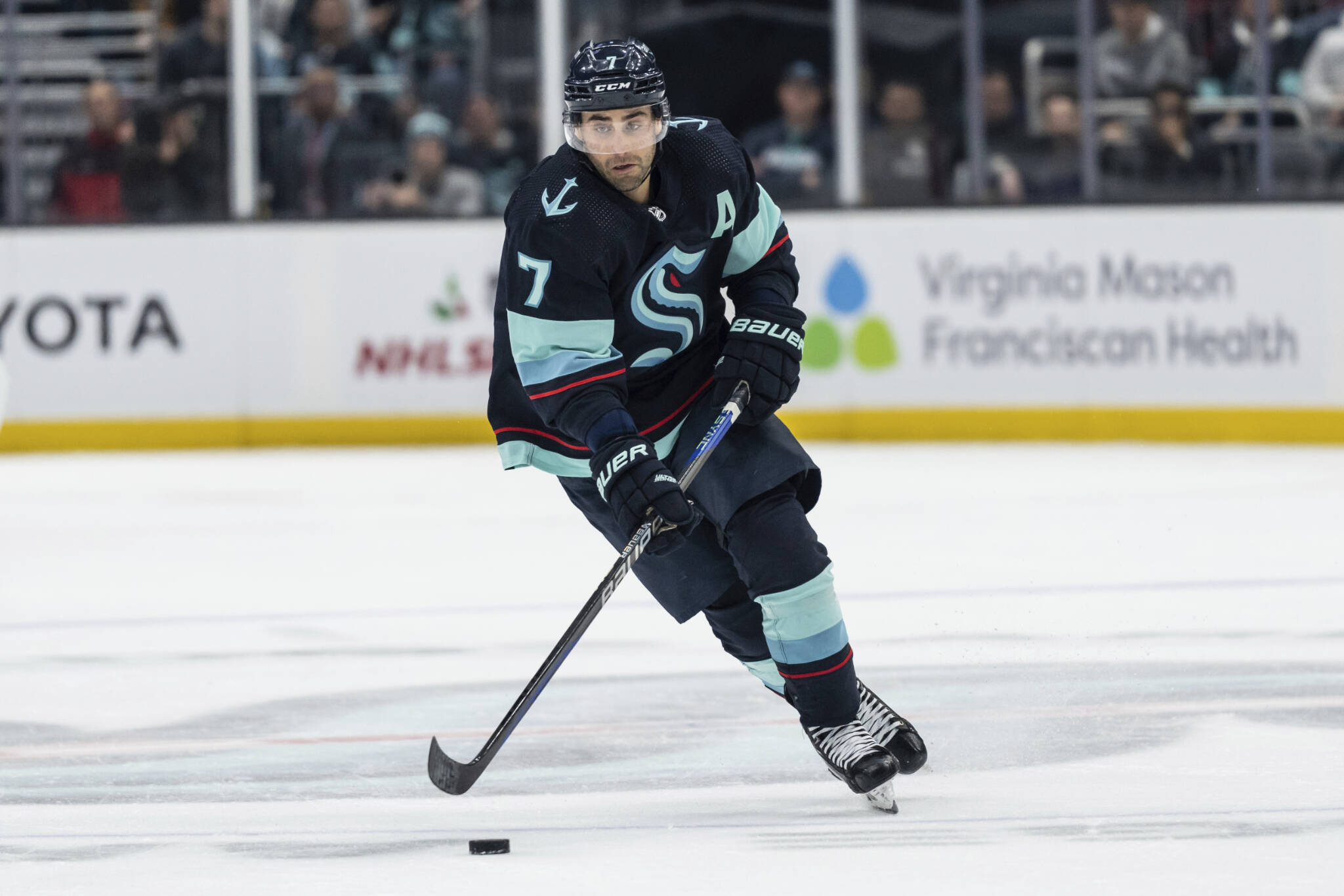By Geoff Baker / The Seattle Times
SEATTLE — It’s been a while since Seattle Kraken backhand artist Jordan Eberle produced a museum-quality work for public display.
But when Eberle hoisted a puck off the cross bar and into the net Sunday night, Climate Pledge Arena connoisseurs of the supposedly lost hockey art of backhanding were especially vocal in their appreciation. Eberle’s one-motion turn in the left faceoff circle and firing the puck on his backhand — using the back and rounded part of his stick blade — certainly caught Winnipeg Jets goalie David Rittich by surprise, considering how rare such endeavors have become.
“I would say 95% of the players nowadays, they have a big hook,” Eberle said Monday after practice, referring to the more curved stick blades that make strong backhand shots difficult. “Whereas, for myself, I have a pretty straight curve, which is rare. I can think of a few others — there’s me, Sidney Crosby uses a straight curve. There are minimal guys in the league that use a straight curve now.”
For those wanting to sound hip to hockey lingo, the straighter blade used by Eberle is a “Modano curve” — named after Michigan native and Hockey Hall of Famer Mike Modano, the highest goal-scoring and point-getting U.S.-born player in NHL history. Modano played from 1989-2011 and was known for the flatter curve on his custom-designed Easton sticks, which makes it easier for players to accurately lift backhand passes or shots.
“I’ve used the same curve since I was a little kid,” Eberle said of his youth hockey days in Regina, Saskatchewan. “I’ve tried to go to a little bit more curve and it just never really panned out, so I stuck with it.”
It shouldn’t surprise that Eberle’s first NHL goal Oct. 7, 2010, for the Edmonton Oilers came on a brilliant deke move in which he deposited the puck top shelf on his backhand behind Calgary Flames goalie Miikka Kiprusoff. Climate Pledge fans got an early look at Eberle’s backhand prowess Halloween night last year when he scored from the right circle on New York Rangers goaltender Igor Shesterkin.
Eberle is a right-handed shot, and Sunday he was hoping to one-time a slap pass from Adam Larsson. But the pass was too far behind him for a one-timer, so Eberle instead continued his motion in a half-turn after corralling the puck and immediately backhand the shot — which clearly caught Rittich off-guard, as did the height of the incoming puck.
“Honestly, it’s just kind of a reaction — turn and fire,” Eberle said. “It’s not like I’m meaning to do it in the moment.”
More hipster hockey lingo will tell you Eberle went “bar down” with his shot — meaning he banked the puck in off the bottom of the cross bar. The shot trajectory needed to do that is quite severe, and those with more curved sticks can’t get that sort of backhand lift without the puck first rolling off the rounded blade.
But the lesser curve for Eberle means the back of his blade is just flat enough to lift the puck before it starts rolling. Backhand shots are tougher for goalies to gauge than forehands, because they can’t always tell where the release point will be.
Curved sticks were rare during the “Original Six” era running through 1967, and the backhand shot flourished as a slap-shot alternative, with players commonly taking them from the faceoff circle or farther away. But Chicago Blackhawks teammates Bobby Hull and Stan Mikita popularized curved blades by the early 1970s, which made it easier to take accurate, deceptive wrist shots and snap shots.
And though the NHL eventually imposed rules limiting stick curvature, more players looking for an edge against increasingly bigger, better-equipped modern goalies began abandoning flat blades in search of better shots. By the time Hall of Famer Dave Keon, the onetime NHL roommate of Kraken general manager Ron Francis, retired from the Hartford Whalers in 1982 he had possibly the last truly flat blade in the league.
Eberle’s backhand ability has helped him become somewhat of a stickhandling master over the years, and getting his blade on pucks is second nature. He’s got an “active stick” while defending, and opponents know he’s capable of batting an errant pass out of midair if they get careless.
“His hand-eye coordination is special,” Kraken coach Dave Hakstol said after Sunday’s goal. “He’s able to do those types of things in tight spaces, and that one was in and out of the net pretty quick.”
Eberle credits his honing of that skill to general manager Lou Lamoriello and coach Barry Trotz preaching the “detail aspect of the game” when he was with the New York Islanders.
“It kind of shifts your mind toward winning hockey,” he said. “I’ve tried to work on it as much as I can and become more of a 200-foot player.”
So he works on positioning his stick at all times in hopes of forcing the occasional turnover. It’s much like defensive linemen in football remembering to lift their hands when an opposing quarterback throws the ball — hoping for that low percentage bat-down play that can turn a game.
He’ll also work on his forechecking, knowing that such aggressiveness can lead to snatching up loose pucks.
And once those pucks get on Eberle’s stick, well, it’s any goalie’s guess whether he’ll go forehand or backhand.
Eberle’s adjoining locker mate Ryan Donato frequently bugs him about the proficiency of his backhand.
“He says that my backhand is better than my wrist shot,” Eberle said. “He’s probably not wrong.”
Talk to us
> Give us your news tips.
> Send us a letter to the editor.
> More Herald contact information.

























